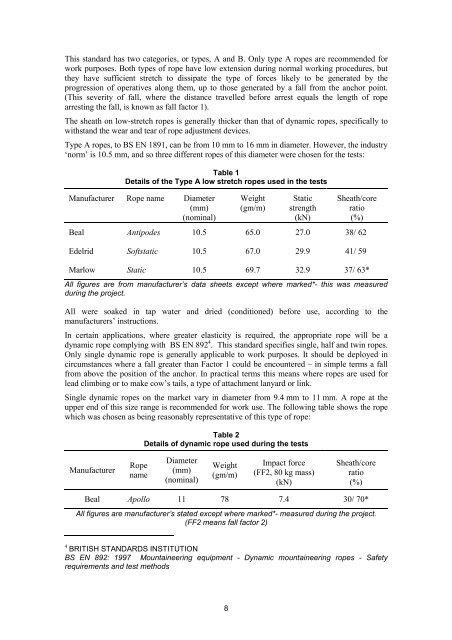HSE: Industrial rope access - investigation into items of personal ...
HSE: Industrial rope access - investigation into items of personal ...
HSE: Industrial rope access - investigation into items of personal ...
Create successful ePaper yourself
Turn your PDF publications into a flip-book with our unique Google optimized e-Paper software.
This standard has two categories, or types, A and B. Only type A <strong>rope</strong>s are recommended for<br />
work purposes. Both types <strong>of</strong> <strong>rope</strong> have low extension during normal working procedures, but<br />
they have sufficient stretch to dissipate the type <strong>of</strong> forces likely to be generated by the<br />
progression <strong>of</strong> operatives along them, up to those generated by a fall from the anchor point.<br />
(This severity <strong>of</strong> fall, where the distance travelled before arrest equals the length <strong>of</strong> <strong>rope</strong><br />
arresting the fall, is known as fall factor 1).<br />
The sheath on low-stretch <strong>rope</strong>s is generally thicker than that <strong>of</strong> dynamic <strong>rope</strong>s, specifically to<br />
withstand the wear and tear <strong>of</strong> <strong>rope</strong> adjustment devices.<br />
Type A <strong>rope</strong>s, to BS EN 1891, can be from 10 mm to 16 mm in diameter. However, the industry<br />
‘norm’ is 10.5 mm, and so three different <strong>rope</strong>s <strong>of</strong> this diameter were chosen for the tests:<br />
Table 1<br />
Details <strong>of</strong> the Type A low stretch <strong>rope</strong>s used in the tests<br />
Manufacturer Rope name Diameter<br />
(mm)<br />
(nominal)<br />
8<br />
Weight<br />
(gm/m)<br />
Static<br />
strength<br />
(kN)<br />
Sheath/core<br />
ratio<br />
(%)<br />
Beal Antipodes 10.5 65.0 27.0 38/ 62<br />
Edelrid S<strong>of</strong>tstatic 10.5 67.0 29.9 41/ 59<br />
Marlow Static 10.5 69.7 32.9 37/ 63*<br />
All figures are from manufacturer’s data sheets except where marked*- this was measured<br />
during the project.<br />
All were soaked in tap water and dried (conditioned) before use, according to the<br />
manufacturers’ instructions.<br />
In certain applications, where greater elasticity is required, the appropriate <strong>rope</strong> will be a<br />
dynamic <strong>rope</strong> complying with BS EN 892 4 . This standard specifies single, half and twin <strong>rope</strong>s.<br />
Only single dynamic <strong>rope</strong> is generally applicable to work purposes. It should be deployed in<br />
circumstances where a fall greater than Factor 1 could be encountered – in simple terms a fall<br />
from above the position <strong>of</strong> the anchor. In practical terms this means where <strong>rope</strong>s are used for<br />
lead climbing or to make cow’s tails, a type <strong>of</strong> attachment lanyard or link.<br />
Single dynamic <strong>rope</strong>s on the market vary in diameter from 9.4 mm to 11 mm. A <strong>rope</strong> at the<br />
upper end <strong>of</strong> this size range is recommended for work use. The following table shows the <strong>rope</strong><br />
which was chosen as being reasonably representative <strong>of</strong> this type <strong>of</strong> <strong>rope</strong>:<br />
Manufacturer<br />
Rope<br />
name<br />
Table 2<br />
Details <strong>of</strong> dynamic <strong>rope</strong> used during the tests<br />
Diameter<br />
(mm)<br />
(nominal)<br />
Weight<br />
(gm/m)<br />
Impact force<br />
(FF2, 80 kg mass)<br />
(kN)<br />
Sheath/core<br />
ratio<br />
(%)<br />
Beal Apollo 11 78 7.4 30/ 70*<br />
All figures are manufacturer’s stated except where marked*- measured during the project.<br />
(FF2 means fall factor 2)<br />
4 BRITISH STANDARDS INSTITUTION<br />
BS EN 892: 1997 Mountaineering equipment - Dynamic mountaineering <strong>rope</strong>s - Safety<br />
requirements and test methods

















